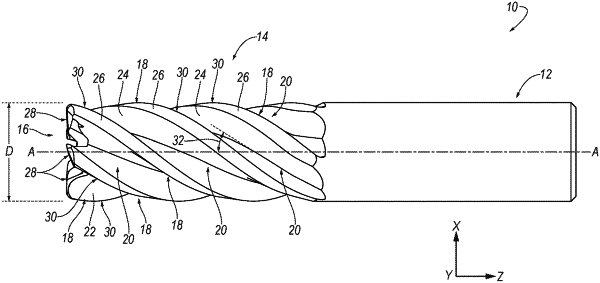| CPC B23C 5/10 (2013.01) [B23C 2210/04 (2013.01)] | 12 Claims |

|
1. A rotary cutting tool, comprising:
a shank portion; and
a cutting portion adjoining the shank portion and having a cutting end, the cutting portion having a plurality of blades separated by flutes, each blade including a leading face, a trailing face, and a land surface extending between the leading face and the trailing face, each blade including an end cutting edge extending from an outer diameter of the cutting portion towards a central, longitudinal axis, A-A, of the rotary cutting tool, and a peripheral cutting edge at an intersection between the leading face and the land surface, the end cutting edge including a first end face cutting edge portion proximate an outer diameter of the rotary cutting tool, and a second end face cutting edge portion adjoining the first end face cutting edge portion and terminating before the central, longitudinal axis of the cutting tool to form a non-center cutting tool,
wherein the first end face cutting edge portion defines a first axial rake angle between about −1 degrees and about −15 degrees with respect to a plane, PZ-PZ, that is substantially parallel to the central, longitudinal axis, A-A, of the rotary cutting tool and a first radial angle between about −2 degrees and about +2 degrees with respect to a plane, PY-PY, that is substantially perpendicular to the central, longitudinal axis, A-A, of the rotary cutting tool, and
wherein the second end face cutting edge portion defines a second axial rake angle between about −1 degrees with respect to the plane, PZ-PZ, that is substantially parallel to the central, longitudinal axis, A-A, of the rotary cutting tool and about −15 degrees and a second radial angle between about 11 degrees and about 15 degrees with respect to the plane, PY-PY, that is substantially perpendicular to the central, longitudinal axis, A-A, of the rotary cutting tool, thereby enabling the rotary cutting tool to perform a ramp operation with a ramp angle of between about 15 degrees and about 45 degrees.
|